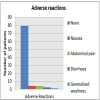The Effectiveness of Myo-Inositol in Women With Polycystic Ovary Syndrome: A Prospective Clinical Study
- PMID: 38469011
- PMCID: PMC10926319
- DOI: 10.7759/cureus.53951
The Effectiveness of Myo-Inositol in Women With Polycystic Ovary Syndrome: A Prospective Clinical Study
Abstract
Background Polycystic ovarian syndrome (PCOS) is a multifaceted complex endocrine disorder showing an alarming rise in women worldwide. Insulin resistance is the chief driving force in the pathogenesis of PCOS. Myo-inositol is an upcoming insulin-sensitizing agent, which is a second messenger responsible for insulin-mediated intracellular glucose transport. This study aims to evaluate the efficacy of myo-inositol and its clinical, hormonal, and metabolic profile in treating women with PCOS. Methodology A prospective clinical study was conducted over 18 months in the Department of Obstetrics and Gynecology at Sree Balaji Medical College and Hospital, Chennai, after obtaining permission from the Institutional Ethical Committee. A total of 90 women diagnosed with PCOS, according to Rotterdam's criteria, were included in the study. They received tablet myo-inositol 1 g BD for six months. Before the start of the therapy, detailed history and baseline investigations were recorded and subsequently re-assessed at the end of six months. Results Around 68% of patients restored menstrual cycle regularity. There was a statistically significant decrease in luteinizing hormone (LH) (10.31 ± 7.92 to 7.42 ± 6.25; p = 0.002), LH/follicle-stimulating hormone ratio (2.34 ± 0.34 to 1.91 ± 0.32; p = 0.000), fasting serum insulin levels (16.71 ± 13.92 to 13.18 ± 9.41; p = 0.041), and homeostatic model assessment for insulin resistance (4.52 ± 1.34 to 2.74 ± 1.28; p = 0.041). Conclusions According to our study, it was observed that myo-inositol led to a statistically significant improvement in the hormonal and metabolic profile of PCOS patients. Moreover, it is safe and has good compliance. Hence, we can justify the addition of myo-inositol to the armamentarium for PCOS management.
Keywords: follicle-stimulating hormone; insulin resistance; luteinizing hormone; metabolic derangements; myo-inositol; polycystic ovarian syndrome.
Copyright © 2024, Sharon P et al.
Conflict of interest statement
The authors have declared that no competing interests exist.
Figures


References
-
- Amenorrhea associated with bilateral polycystic ovaries. Stein IF, Leventhal ML. Am J Obstet Gynecol. 1935;29:181–191.
-
- Polycystic ovary syndrome - from gynaecological curiosity to multisystem endocrinopathy. Homburg R. Hum Reprod. 1996;11:29–39. - PubMed
-
- Prevalence of polycystic ovarian syndrome in Indian adolescents. Nidhi R, Padmalatha V, Nagarathna R, Amritanshu R. J Pediatr Adolesc Gynecol. 2011;24:223–227. - PubMed
LinkOut - more resources
Full Text Sources
